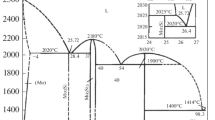Abstract
Within the group of boride and suicide containing hard alloys, those based on copper have recently found increasing interest as wear-resisting stratification and high-temperature structural materials. For the development of the best alloy, the phase conditions in the systems nickel-copper-boron and nickel-copper-silicon were elucidated from the isothermal profiles at 700°.
Melting behaviours (important from a practical point of view) in the area of low metalloid contents are presented in the cases of (Ni-Cu-B) mixed crystals, Ni3B alloy, as well as Ni-Cu-10 atomic % B and Ni-Cu-10 atomic % Si.
Résumé
Dans le groupe des alliages durs contenant des borures et des siliciures, ceux à base cuivre ont présenté depuis ces dernièrs temps un intérêt croissant comme matériaux de revêtement résistant à l'usure et comme matériaux d'assemblage aux températures élevées. Afin d'établir les principes du développement optimal de ces alliages, on a mis au point les relations entre phases dans les systèmes nickel-cuivre-bore et nickel-cuivre-silicium sur des coupes isothermes à 700° et montré que la fusion se produit dans le domaine des faibles teneurs en métalloïdes, ce qui est important du point de vue des applications. Les alliages du domaine cristaux mixtes (Ni-Cu-B)-Ni3B ainsi que les coupes température-concentration Ni-Cu-10 At. % B et Ni-Cu-10 At. % Si ont servi d'exemples.
Zusammenfassung
Innerhalb der Gruppe der borid- und silicidhaltigen Hartlegierungen finden solche auf Kupferbasis in jüngster Zeit zunehmend Interesse als verschleißfeste Beschichtungswerkstoffe und Hochtemperaturfügewerkstoffe. Als Grundlage für eine optimale Legierungsentwicklung wurden die Phasen Verhältnisse in den Systemen Nickel-Kupfer-Bor und Nickel-Kupfer-Silicium in isothermen Schnitten bei 700° geklärt und das anwendungs-technisch wichtige Schmelzverhalten im Bereich niedriger Metalloidgehalte am Beispiel von Legierungen des Gebietes (Ni-Cu-B)Mischkristall-Ni3B sowie der Temperatur-Konzentrationsschnitte Ni-Cu-10 At.-% B und Ni-Cu-10 At.-% Si aufgezeigt.
Резюме
В последнее время все большее внимание при влекает группа боридных к сил ицидных твердых сплавов на ме дной основе, как износоустойчивых и в ысокотемпературных структурных материа лов. Ради разработки н аилучших сплавов, были выяснен ы фазовые равновесия систем ни кель-медь-бор и никель-медь-кремний, н а основе их изотермич еских профилей при 700°. Для Ni-Cu-B, к ак для системы с низки м содержанием металли да, для сплава Ni3B, а также дл я системы Ni-Cu-10 ат.% Ви Ni-Cu-10 ат.% Si представлены их характерные черты плавления, что являет ся важным с практической точки зрения.
Similar content being viewed by others
Literature
E.Lugscheider, O.Knotek und H.Reimann, Proc. Intern. Conf. GEFTA 1977, Clausthal-Zellerfeld.
O. Knotek, E. Lugscheider undH. Eschnauer, Hartlegierungen zum Verschleißschutz, Verlag Stahleisen, Düsseldorf 1975.
E. Lugscheider undH. Reimann, Monatshefte f. Chem., 108 (1977) 1005.
demnächst
E.Lugscheider, Proc. 5. Int. Conf. Therm. Anal., Kyoto, 1977, p. 98.
Author information
Authors and Affiliations
Additional information
Auszugsweise vorgetragen auf der GEFTA-Tagung 1977 in Clausthal-Zellerfeld[1].
Rights and permissions
About this article
Cite this article
Lugscheider, E., Reimann, H. Aufbau und Schmelzverhalten von Nickel-Kupfer-Bor und Nickel-Kupfer-Silicium Legierungen. Journal of Thermal Analysis 16, 285–290 (1979). https://doi.org/10.1007/BF01910690
Received:
Issue Date:
DOI: https://doi.org/10.1007/BF01910690




